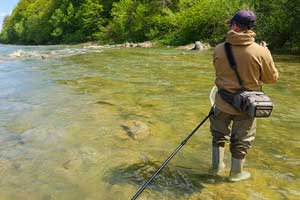Rainbow Trout Habitat

Rainbow Trout and their sea-run brothers the Steelhead Trout, are found around the world in all of the continents except for the icy Antarctica.
While their natural distribution was much smaller, their popularity and ability to survive significant temperature ranges has allowed them to survive in warm places like Africa.
Where to find Rainbow Trout
Rainbow trout is a cold water fish species that can be found in both freshwater and saltwater.
Stream dwelling Rainbow trout are usually small to moderately large and found in shallow rivers with moderate flow and gravel bottoms. They’re usually located in pool or riffles when they’re not traveling.
- Those that are found only in freshwater are called Rainbow Trout.
The lake resident Rainbow Trout are usually found in moderately deep, cool lakes with adequate shallows and vegetation that creates a stable environment for the food chain.
For a lake population to be self-sustaining, rivers must feed into the lake that offer the gravel aggregate that they prefer and must be clear and cool.
Temperature is not the most significant requirement for their habitat.
Essentials for their habitat are
- gravel substrate and sandy bottoms because these conditions are critical to their ability to spawn and survive
- an abundance of food
What kind of fish is a Steelhead?
Rainbow Trout that are sea-run are called Steelhead. There’s no difference in their DNA. One is land locked and freshwater dwelling only while the other spends most of its life in the sea.
Spawning Habitat
Rainbow and Steelhead Trout both spawn in rivers and streams that provide a gravel aggregate or at least offer a mix of sand and gravel.
The female digs a redd (nest) in the gravel by turning on her side and beating her tail up and down. The redd is usually dug in a riffle or pool or in the headwater of a stream. Their preferred habitat are mountain runoff streams and rivers.
The eggs are laid in between the gravel. Once the eggs have been laid, the female begins digging at the upstream edge of the nest covering the eggs with the displaced gravel. The eggs usually hatch in approximately 4 to 7 weeks. The time of hatching varies greatly with region and habitat. For more on rainbow trout reproduction, click here
Rainbow Trout food preferences
Once hatched, the fry begin feeding which consists mainly on zooplankton.
The growth rate of Rainbow Trout varies dependent on the area, habitat, life history, quality and quantity of food.
Adult Rainbow Trout feed close to the bottom of their habitat. These are predatory fish that feed on both aquatic and terrestrial insects, molluscs, crustaceans, various fish species and fish eggs.



